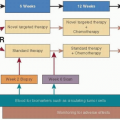childbirth was significantly associated with death (RR = 1.58, 95% confidence interval 1.24-2.02) compared to patients who gave birth more than 5 years before their breast cancer diagnosis (8). These studies were not able to control for delay in diagnosis, treatment, or treatment modalities of the breast cancer. Future translational research may help identify whether or not there is a true biologic difference in breast cancers diagnosed soon after pregnancy to account for these differences. A recent case-control study concludes that current or recent pregnancy is associated with adverse pathologic features but breast cancer survival is not impaired (9).
marker evaluation. Core or excisional biopsies can be performed safely with local anesthesia, with only one found report of the development of a milk fistula after a core needle biopsy (22).
TABLE 65-1 U.S. FDA Pregnancy Category Definitions | ||||||||||
|---|---|---|---|---|---|---|---|---|---|---|
|
the first trimester. There was, however, an increase in the frequency of low- and very-low-birth-weight infants. This was attributed to the underlying illness or trauma necessitating the surgery (32). In a Canadian report of 2,565 pregnant women who underwent surgery, Duncan et al. reported no increase in fetal abnormalities compared to a control population of pregnant women who did not have an operation (33). A recent review of surgery in the pregnant patient recommends that the preferred timing for surgical intervention is 16 to 20 weeks of gestation (34).








